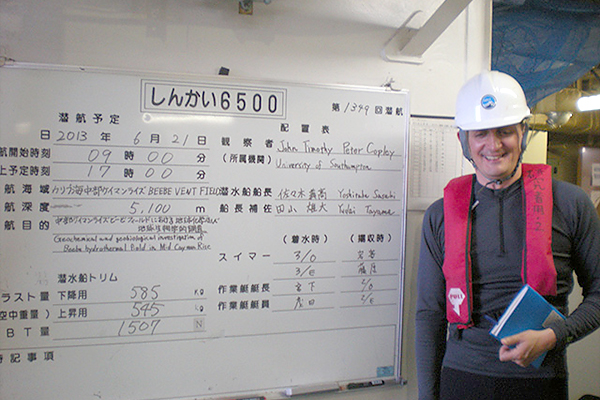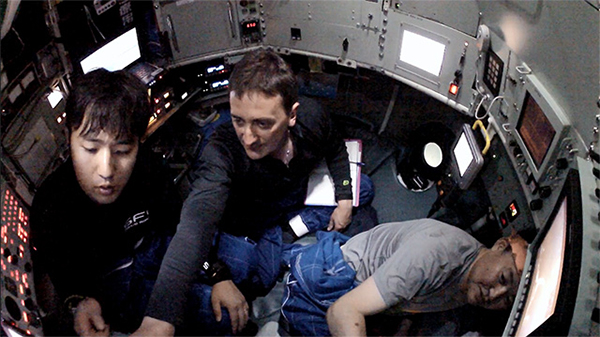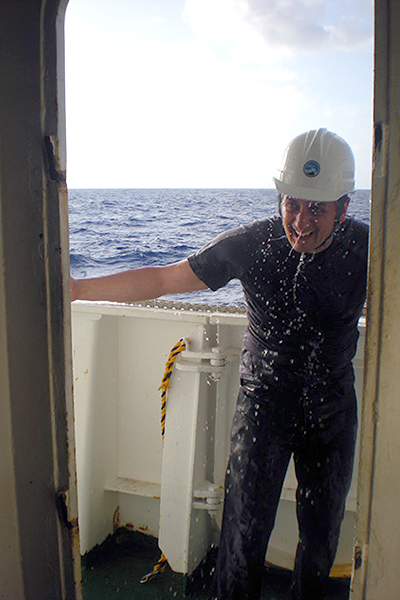QUELLEレポート
この惑星の最も素敵なところ,深海を知るために。
2013/06/25
Jonathan Timothy Peter Copley(University of Southampton)
(いま最も英国で勢いのある深海生物学者、かつ本場英国の海底紳士こと、ジョン・コプリ博士は、この世界最深の熱水域をもっともよく知る研究者のひとりです。本航海第1回目の潜航調査の様子を原文のまま英語でお届けします。みなさま辞書を片手に、いやいや、それムリだし、という方は和訳版をどうぞ。)

本航海に英サウザンプトン大学を率いて参加する海底紳士コプリ博士。世界最深の熱水噴出域ミッドケイマンライズをもっともよく知る研究者のおひとりです。
Five kilometres - or 3.1 miles - is not a great distance on land; the length of a pleasant walk. But five kilometres vertically in the ocean is a distance that separates two different worlds. So it was with great excitement that I climbed into the metal sphere of the Shinkai6500 this morning with pilot Yoshitaka Sasaki and co-pilot Yudai Tayama, ready to make a dive to the Beebe Vent Field five kilometres below the RV Yokosuka.
Five minutes after we left the surface, we passed 200 metres depth and entered the "twilight zone", where the sunlight from the surface is already too dim for organisms to photosynthesise. The colour of the water outside the porthole became the deepest blue you can possibly imagine - a colour famously described as "luminous black" by deep-sea pioneer William Beebe, after whom the vents below us are named. Beebe and his colleague Otis Barton became the first people to venture into the deep ocean when they dived in their bathysphere in the 1930s, and both are ocean heroes to me.
At 09.29 we passed 923 metres depth -- the maximum depth reached by Beebe and Barton in 1934. Moments later we entered the "midnight zone" beyond 1000 metres deep, where no sunlight penetrates. At 09.56 we passed 2200 metres depth - a personal milestone, as that was the deepest I had been before, but this time not even halfway to the seafloor. And forty minutes later we passed 3800 metres depth, which is the average depth of the ocean. Finally, after sinking through the ocean like a stone for two hours, we approached the ocean floor at a depth of 5103 metres.
To reach the Beebe Vent Field, we travelled across the landscape of the ocean floor, which changed from a flat plain of fine mud to a steep slope of grey lava blocks, and eventually rust-coloured sulfides - the minerals formed by the vents. Soon afterwards, we arrived at our target site: a set of "black smoker" chimneys called "Hashtag".
The hot fluids from these slender mineral spires shoot nearly a kilometre into the ocean above, and sitting next to this force of nature in the Shinkai6500 was a humbling experience. We quickly began collecting samples of rocks, the hot fluids gushing from the vents, and the creatures living around them: pristine white anemones with gentle wafting tentacles, and orange-coloured shrimp crawling over sides of the vent chimneys.
During the few minutes of waiting for our water sampler to collect high-temperature fluids from the vent chimneys, I enjoyed a delicious packed lunch of rice balls, fish, and omelette, with green tea. To visit a Japanese restaurant is a treat in the UK, so my meals aboard the RV Yokosuka have been a rare pleasure, and to dine today at the ocean floor even more so.
Eventually, the time for our visit to the vents was over, and we left the seafloor to begin our return journey to the world above. But the deep ocean had one further gift to give: with the lights switched off during our ascent, I could watch the bioluminescent displays of deep-sea creatures through the porthole: flashes of light in the inky darkness triggered by the passing of our submersible.
By 17.32 the Shinkai6500 was secure again on the deck of RV Yokosuka, where our scientific colleagues were waiting to rush our payload to the laboratories aboard the ship. We hope that these samples will help in the efforts to understand the limits of life, and more about how our planet works.
William Beebe once wrote that if you visit the deep ocean and return speechless with wonder, then you deserve to go again. For me, the wonder of visiting the world’s deepest known vents today will never fade. My team and I from the University of Southampton are profoundly grateful for the invitation to join in the voyage of the RV Yokosuka and Shinkai6500, and for the warm welcome that we have received from all aboard. We look forward to making future voyages together to continue the exploration of our planet’s greatest realm.

「しんかい6500」パイロットの佐々木さん、田山さんとともに深海へ潜入するコプリ博士
(緊急特別参戦してくれた10カ国語に堪能な「海底紳士スケおじさん」とガッツ矢萩さんが頑張ってくれた和訳版はここから)
5 キロメートル,あるいは 3 .1マイルという距離は,陸上の場合,大したものではなく,むしろウォーキングにはちょうどいい距離だ。しかし,この5キロメートルという距離を,海の深さ方向にとるなら,それは世界を2つに分かつ距離と言うことができよう。
今朝,佐々木義高潜水船船長と田山雄大船長補佐と共に「しんかい6500」にかかる鉄梯子を上り,「よこすか」の直下5 kmに存在する「ビービ熱水噴出域」の潜航調査へ出発しようという時,私は心の底から興奮していた。
海表面を出発してから5分後,私たちは水深200mを通過した。この辺りは,太陽光が減衰し、光合成をするには暗すぎる「トワイライト・ゾーン」と呼ばれる領域である。
船窓から見える海水の色は深い深い青色。あなたも想像することができるだろうか。その色は,深海の開拓者であるウィリアム・ビービ(William Beebe)によって「光る黒色(luminous black)」と表現されている。そう,私たちが向かう熱水噴出域の名は,彼に由来している。
1930年代に、自ら作成した潜水艇「バチスフィア」に乗り込み,世界で初めて深海を冒険したビービと,彼の盟友であるオーティス・バートン(Otis Barton)は,私の「オーシャン・ヒーロー」である。
9時29分,私は 1934年にビービとバートンが達成した最大水深923mを通過した。 その5分後,私たちは1000mを越える「ミッドナイト・ゾーン」(midnight zone)に入った。
ここにはもう,光は届かない。9時56分,これまでに私が訪れた最大水深であり,私の人生におけるひとつのマイルストーンでもあった2200メートルを通過したが,それでもまだ,今回の海底までの潜航ではまだ半分にも満たない。40分後,私たちは海洋の平均水深である3800mを通過し,2時間かけて石のように海中を沈んだ後,私たちはようやく水深5103mの海底に辿りついた。
ビービ熱水噴出域に向けて,私たちは移りゆく海底の風景を旅した。はじめは細かい泥の平坦な海底面,つづいて灰色の溶岩片が転がる急斜面,そして熱水活動によって形成される錆色の硫化物を視認したすぐ後,私たちはついに,ターゲットサイトであるハッシュタグ(Hashtag)と名付けられたブラックスモーカーチムニー群に辿りついた。
細く長く伸びた針のようなチムニーから1キロメートルも上昇するぐらいに力強く噴出する熱水,そのすぐ脇に「しんかい6500」で着底した私は,この自然の驚異を目の当たりにし,自分の小ささを感じざるをえなかった。
私たちはただちに試料の採取を開始した。ここではチムニー片,高温熱水,さらに噴出孔周辺に生息する生物達,たとえば上品に触手を棚引かせる白いイソギンチャクやチムニーの外側を覆いつくすオレンジ色のエビなどを採集した。
高温熱水を採水器で採取するのを待つ数分の間,私は,おにぎりと魚とオムレツの入ったおいしいお弁当と日本茶を楽しんだ。英国では日本料理屋での食事は御馳走であるため,「よこすか」船上での日々の食事は貴重な喜びであり,今日のように海底でいただくのであればなおさらである。
私たちの熱水噴出域滞在は終了時間を迎え,もう一つの世界へ戻るために海底から離れた。しかし,熱水噴出域を離れてなお,深海はさらに贈り物を与えてくれた:上昇する間「しんかい6500」の照明を落とすと,船窓から深海生物の発する光を観察することができた。潜水船の通過が彼らへの刺激となり,暗闇に光が発せられるのである。
17時32分,「しんかい6500」は「よこすか」のデッキへ帰還した。そこには私の仲間が,今回のサンプルを船上の研究室へ運ぶため,今や遅しと待ちかまえていた。私たちは,これらのサンプルが生命の限界,さらには私たちの惑星がどのように機能しているかを理解するための一助となることを祈っている。
ビービはかつて,「もしあなたが海底を訪れ,言葉にならない感動とともに生還を果たしたなら,あなたはきっともう一度深海を訪れる恩寵を受けることだろう」と記述している。今日,世界最深の熱水噴出域へと潜航した感動は,私にとって二度と消えることはないだろう。英国サウサンプトン大学から来た私たちは,この度の「よこすか/しんかい6500」航海への参加と温かな歓迎に対し,心から感謝を申し上げたい。そして今後も皆さんと共に航海調査できることを楽しみにしている。この惑星の最も素敵なところ,深海を知るために。

お約束の「しんかい6500」初潜航者への水かけにも「バッチコーイ!」と楽しんでいました。
(まさに英国海底紳士らしく、落ち着き払った、しかし世界最深の熱水噴出域を目の前で見た感動を伝えていただきました。ビービの言葉「もしあなたが海底を訪れ,言葉にならない感動とともに生還を果たしたなら,あなたはきっともう一度深海を訪れる恩寵を受けることだろう」は、「ビービ熱水フィールド」に潜航した「しんかい6500」のリアル生中継を視聴した30万人以上の人達が本当にそのリアリティーに共感してくれていたとしたら、いつかその人達が再び本当に深海を訪れることができる日がやってくることの啓示であるかのような気がしてなりません...。さて、次回は、「航海プリンセス」ことJAMSTEC海洋生態研究員の渡部裕美さんと、人生初潜航を成し遂げた英サウザンプトン大学の姫様ベリティさんによる「真夏のカリブ海決戦」をお届けいたします。ではまた!)